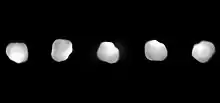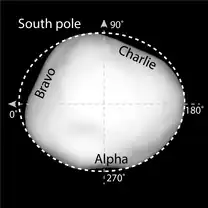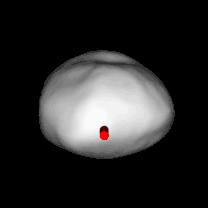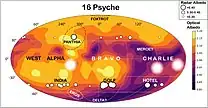 | |
| Discovery | |
|---|---|
| Discovered by | Annibale de Gasparis |
| Discovery site | Naples Observatory |
| Discovery date | 17 March 1852 |
| Designations | |
Designation | (16) Psyche |
| Pronunciation | /ˈsaɪkiː/[1] |
Named after | Psyche (Ψυχή) |
| Main belt | |
| Adjectives | Psychean (/saɪˈkiːən/)[2] |
| Symbol | |
| Orbital characteristics[3] | |
| Epoch 13 September 2023 (JD 2460200.5) | |
| Aphelion | 3.32 AU (497 million km) |
| Perihelion | 2.53 AU (378 million km) |
| 2.92 AU (437 million km) | |
| Eccentricity | 0.1342 |
| 4.999 yr (1825.95 d) | |
| 243.16° | |
| Inclination | 3.096° |
| 150.03° | |
| 27 April 2025 | |
| 229.41° | |
| Earth MOID | 1.53 AU (229 million km) |
| Physical characteristics | |
| Dimensions | c/a = 0.59±0.02[4] (278±5 × 232±6 × 164±4) km[5] [best ellipsoid fit = 277 km × 238 km × 168 km][5] 279 × 232 × 189 km ( ± 10% )[6] (278+4 −8 × 238+4 −6 × 171+1 −5) km[7] |
Mean diameter | 223±3 km[4] 222±4 km[5] 222+1 −4 km[7] |
| Volume | 5.75×106 km3 (best fit)[7] |
| Mass | (2.29±0.14)×1019 kg[8] |
Mean density | 3.977±0.253 g/cm3 |
| ~0.144 m/s2[6] | |
| ~180 m/s[6] (~600 ft/s) | |
| 4.195948±0.000001 h[6][7] | |
| Albedo | 0.15±0.03[5] 0.34±0.08 (radar)[7] |
Spectral type | Tholen = M[3] SMASS = X[3] Bus-DeMeo = Xk[9] |
| 9.22 to 12.19 | |
| 6.21[3] | |
16 Psyche (/ˈsaɪkiː/ SY-kee) is a large M-type asteroid, which was discovered by the Italian astronomer Annibale de Gasparis, on 17 March 1852 and named after the Greek goddess Psyche.[10] The prefix "16" signifies that it was the sixteenth minor planet in order of discovery. It is the largest and most massive of the M-type asteroids, and one of the dozen most massive asteroids. It has a mean diameter of approximately 220 kilometers (140 mi) and contains about one percent of the mass of the asteroid belt. It was thought to be the exposed core of a protoplanet,[11] but recent observations cast doubt on that hypothesis.[8][7] Psyche will be explored by NASA, with a spacecraft of the same name, marking the first time a manmade object will journey to a metallic asteroid, launched on 13 October 2023,[12] with an expected arrival in 2029.[13]
Symbol

Astronomers created icon-like symbols for the first fifteen asteroids to be discovered, as a type of shorthand notation consistent with older notation for the classical planets. Psyche was given an iconic symbol, as were a few other asteroids discovered after 16 Psyche. The symbol was a butterfly's wing topped by a star (![]() or
or ![]() ), as the butterfly was a Greek symbol of the soul (psyche being the Greek word for both "butterfly" and "soul").[14] This symbol may have influenced the design of the official insignia for the NASA Psyche mission to this asteroid. It is in the pipeline for Unicode 17.0 as U+1CEC9 (
), as the butterfly was a Greek symbol of the soul (psyche being the Greek word for both "butterfly" and "soul").[14] This symbol may have influenced the design of the official insignia for the NASA Psyche mission to this asteroid. It is in the pipeline for Unicode 17.0 as U+1CEC9 (![]() ).[15][16]
).[15][16]
However, the iconic symbols for all asteroids were superseded before Psyche's symbol ever came into use. With more than a dozen asteroids discovered, remembering all their individual emblems became increasingly cumbersome, and, in 1851, German astronomer J.F. Encke suggested using a circled number instead: ⑯. The first asteroid designated with the new scheme was ⑯ Psyche, when American astronomer J. Ferguson published his observations in 1852.[17]
Characteristics
Size
The first size estimate of Psyche was 253 kilometres (157 mi) and came from IRAS thermal infrared emission observations.[3] This is 15% larger than the currently accepted mean value, but was later found to be an accurate estimate for the IRAS viewing aspect because Psyche was viewed pole-on at the time of the measurement.[6][18]
Psyche has been observed to occult a star on nine occasions.[6] Four of these, 2004,[6] 2010,[19][20] 2014,[19] and 2019,[21] generated multi-chord data sets[19] and have been used along with adaptive optics imaging and three-dimensional modeling to estimate Psyche's mean diameter, with recent models all converging to an equivalent-volume mean diameter of 222±3 km.[22][23][24][5][7]

Mass and bulk density
Psyche is massive enough that its gravity observably perturbs other asteroids' orbits, which can be used to calculate a mass estimate. Historical values for Psyche's mass have ranged from 1.6×1019 kg to 6.7×1019 kg.[8] However, most recent estimates have begun to converge on values near (2.287±0.070)×1019 kg.[8][25] Assuming the mean volume of (5.75±0.19)×106 km3, this equates to a bulk density of 3.977±0.253 g/cm3, which is considerably higher than most small Solar System bodies.[4][8][25]
Shape and spin pole
The first published three-dimensional shape model for Psyche was derived from an analysis of numerous light curves.[26] Since then, additional refinements to the shape have been made based on the inversion of lightcurves, adaptive optics observations, radar observations, thermal imaging, and occultations.[22][6][27][24][5][7][4] The most recent models show that Psyche has a shape consistent with a Jacobi ellipsoid and dimensions within a few km of 278 km x 238 km x 171 km.[24][4][7][5]
Each shape model provides an estimate of the direction of the north pole (spin axis). All recent models for Psyche suggest it rotates about a pole pointed towards the ecliptic coordinates (long, lat) λ = 35°, β = -8°, with a 3° uncertainty.[22][6][27][24][5][7] This means that it is essentially tilted toward the ecliptic, with an axial tilt of 98°.
Features

Many features have been reported on Psyche. The largest of these are regions of mass-deficits relative to its nominal ellipsoid shape and are reminiscent of the Rheasilvia basin on 4 Vesta.[7][5][24][6]
In addition to the large-scale regions of mass-deficit, several apparent craters have been reported. Observers using the Very Large Telescope's adaptive optics SPHERE imager reported two large craters, on the order of 90 km across, which were provisionally named Meroe /ˈmɛroʊiː/ and Panthia /ˈpænθiə/, after the twin witches in the Roman novel Metamorphoses by Apuleius.[28][24] Observers using the Arecibo Radar Telescope reported craters at the south pole (referred to as Delta),[6] southern midlatitudes (referred to as Eros),[6][7] and the north pole (referred to as Foxtrot).[7] An analysis of the features present in several independent shape models suggests that craters Panthia and Eros are almost certainly real and Foxtrot is likely to be real. However, there is uncertainty over the existence of Meroe and Delta.[7]
Early lightcurve studies suggested that Psyche has large variations in its surface brightness.[29] These variations became more evident when attempts were made to invert lightcurves to generate shape models.[26][6] The most recent shape models based on lightcurve inversions simultaneously solve for surface albedo variations,[24][5] and the resulting maps show regions where local albedo differs from the mean albedo by more than 20% in either direction. Notably, the Meroe crater coincides with an area much darker than the mean, and the Panthia crater coincides with an area much brighter than the mean.
Radar observations with the Arecibo Radar Telescope revealed that Psyche's "background" radar albedo is , comparable to other M-type asteroids like 21 Lutetia.[7] This value is consistent with a silicate (rocky) regolith enriched in metal phases.[30] However, in at least three locations, Psyche's radar albedo is nearly twice this value, suggesting high concentrations of metal phases in these regions.[7] One of these locations corresponds with the optically bright Panthia crater, while the other two correspond with regions that have been reported as optically bright.[5][24][7] This apparent correlation between optical and radar albedos on Psyche has led to the hypothesis that there is a link between the process(es) that create regions of high metal content and brighter terrain.[7]
Composition
The bulk density of Psyche (3.9±0.3 g/cm3) places constraints on its overall composition. The iron-nickel found in most iron meteorites has a bulk density of 7.9 g/cm3. If Psyche were the remnant core of an early planetesimal, it would have to have an overall porosity of 50%. Given Psyche's size, this is considered highly improbable.[8] However, there are other metal-rich meteorite types that have been suggested as Psyche analogs, each of which have bulk densities that are similar to Psyche's, including enstatite chondrites, bencubbinites, and mesosiderites.[31][24][8]
Several observers have reported the presence of silicate minerals on the surface of Psyche.[32][33][34] Spectra taken in October 2016 at the NASA Infrared Telescope Facility at the Mauna Kea Observatories showed evidence (~3 μm absorption feature) of hydroxyl ions on the asteroid that may suggest the presence of hydrated silicates.[35] Since Psyche is thought to have formed under dry conditions without the presence of water, the hydroxyl may have reached Psyche via past impacts from smaller carbonaceous asteroids.[35][30]
Psyche's radar albedo varies considerably over the surface, ranging from 0.22 to 0.52,[7] values that are two to four times as high as most main-belt asteroids.[36] Models of radar reflection equate this range of values with regolith bulk densities of 2.6 to 4.7 g/cm3.[30] This range is consistent with most of the metal-rich meteorite classes noted above and the spectroscopic detection of silicate minerals. It is inconsistent with a pure iron-nickel regolith unless it is highly porous.

Origin
Several possible origins have been proposed for Psyche. The earliest of these was that Psyche is an exposed metallic core resulting from a collision that stripped away the crust and mantle of an originally larger differentiated parent body some 500 kilometers in diameter.[11] Other versions of this include the idea that it was not the result of a single large collision but multiple (more than three) relatively slow sideswipe collisions with bodies of comparable or larger size.[37] However, this idea has fallen out of recent favor as mass and density estimates are inconsistent with a remnant core.[8]
A second hypothesis is that Psyche was disrupted and gravitationally re-accreted into a mix of metal and silicate.[38] In this case, it may be a candidate for the parent body of the mesosiderites, a class of stony–iron meteorites.[38]
A third hypothesis is that Psyche may be a differentiated object, like 1 Ceres and 4 Vesta, but has experienced a type of iron volcanism, also known as ferrovolcanism, while still cooling.[39] If true, this model predicts that metal would be highly enriched only in those regions containing (relic) volcanic centers. This view has been bolstered by recent radar observations.[7]
Exploration

No spacecraft has visited Psyche, but a mission to Psyche was proposed to NASA in 2014.[40][41] A team led by Lindy Elkins-Tanton,[42] the director of the School for Earth and Space Exploration at Arizona State University, presented a concept for a robotic Psyche orbiter. This team argued that 16 Psyche would be a valuable object for study because it is the only metallic core-like body discovered so far.[41]
The spacecraft would orbit Psyche for 20 months,[40] studying its topography, surface features, gravity, magnetism, and other characteristics and would be based on current technology, avoiding high cost and the necessity to develop new technologies. On 30 September 2015, the Psyche orbiter mission was one of five Discovery Program semifinalist proposals.[43]
The mission was approved by NASA on 4 January 2017 and was originally targeted to launch in October 2023, with an Earth gravity assist maneuver in 2024, a Mars flyby in 2025, and arriving at the asteroid in 2030.[44] In May 2017, the launch date was moved up to target a more efficient trajectory, launching in 2022, with a Mars gravity assist in 2023 and arriving in 2026.[45] However, problems with Psyche's flight software led NASA to revert to the original launch timeline.[46]
On 28 February 2020, NASA awarded SpaceX a US$117 million contract to launch the Psyche spacecraft, and two smallsat secondary missions, on a Falcon Heavy rocket.[47] The spacecraft was successfully launched on 13 October 2023, at 14:20 UTC,[12] with an expected arrival in 2029.[13]
Asteroid Psyche has an Earth-MOID of 1.5 AU (220 million km; 580 LD),[3] and will next come to opposition on 6 August 2024 when it will be 1.7 AU (250 million km; 660 LD) from Earth.[48]
See also
References
- ↑ Webster, Noah (1884). "Psyche (/ˈsaɪkiː/)". A Practical Dictionary of the English Language.
- ↑ "Psychean (/saɪˈkiːən/)". Oxford English Dictionary. "psyche". Oxford English Dictionary (Online ed.). Oxford University Press. (Subscription or participating institution membership required.)
- 1 2 3 4 5 6 "JPL SBDB: 16 Psyche". JPL Small-Body Database Browser (2021-12-09 last obs). Jet Propulsion Laboratory. Archived from the original on 10 April 2020. Retrieved 16 September 2023.
- 1 2 3 4 5 P. Vernazza; M. Ferrais; L. Jorda; J. Hanuš; et al. (4 October 2021). "VLT/SPHERE imaging survey of the largest main-belt asteroids: Final results and synthesis" (PDF). Astronomy & Astrophysics. 654: A56. Bibcode:2021A&A...654A..56V. doi:10.1051/0004-6361/202141781. S2CID 239104699. Archived (PDF) from the original on 12 October 2021. Retrieved 14 October 2021.
- 1 2 3 4 5 6 7 8 9 10 11 Ferrais, M.; Vernazza, P.; Jorda, L.; Rambaux, N.; Hanuš, J.; Carry, B.; et al. (June 2020). "Asteroid (16) Psyche's primordial shape: A possible Jacobi ellipsoid?" (PDF). Astronomy and Astrophysics. 638: L15. Bibcode:2020A&A...638L..15F. doi:10.1051/0004-6361/202038100. S2CID 225802158. Archived (PDF) from the original on 27 April 2021.
- 1 2 3 4 5 6 7 8 9 10 11 12 13 Shepard, Michael K.; Richardson, James; Taylor, Patrick A.; et al. (2017). "Radar observations and shape model of asteroid 16 Psyche". Icarus. 281: 388–403. Bibcode:2017Icar..281..388S. doi:10.1016/j.icarus.2016.08.011.
- 1 2 3 4 5 6 7 8 9 10 11 12 13 14 15 16 17 18 19 20 Shepard, Michael K.; De Kleer, Katherine; Cambioni, Saverio; Taylor, Patrick A.; Virkki, Anne K.; Rívera-Valentin, Edgard G.; Rodriguez Sanchez-Vahamonde, Carolina; Fernanda Zambrano-Marin, Luisa; Magri, Christopher; Dunham, David; Moore, John; Camarca, Maria (2021). "Asteroid 16 Psyche: Shape, Features, and Global Map". The Planetary Science Journal. 2 (4): 125. arXiv:2110.03635. Bibcode:2021PSJ.....2..125S. doi:10.3847/PSJ/abfdba. S2CID 235918955.
- 1 2 3 4 5 6 7 8 Elkins-Tanton, L. T.; et al. (2020). "Observations, meteorites, and models: A preflight assessment of the composition and formation of (16) Psyche". Journal of Geophysical Research: Planets. 125 (3): 23. Bibcode:2020JGRE..12506296E. doi:10.1029/2019JE006296. PMC 7375145. PMID 32714727. S2CID 214018872.
- ↑ "EAR-A-5-DDR Taxonomy". Planetary Data System (v 6.0 ed.). Archived from the original on 17 December 2015. Retrieved 16 April 2018.
- ↑ Schmadel, Lutz D. (2012). Dictionary of Minor Planet Names (6th ed.). Springer Science & Business Media. pp. 14–15. ISBN 978-3642297182.
- 1 2 Bell, J.F.; et al. (2015). Richard P. Binzel; Tom Gehrels; Mildred Shapley Matthews (eds.). Asteroids: The Big Picture in Asteroids II. University of Arizona Press. pp. 921–948. ISBN 978-0-8165-1123-5.
- 1 2 Wall, Mike (28 September 2023). "NASA's Psyche Mission Targeting Oct. 12 for Launch". blogs.nasa.gov. Nasa. Archived from the original on 29 September 2023. Retrieved 30 September 2023.
- 1 2 "NASA Continues Psyche Asteroid Mission". JPL. NASA. 28 October 2022. Archived from the original on 8 November 2022. Retrieved 28 October 2022.
- ↑
Sonntag, A. (1852). "Elemente und Ephemeride der Psyche". Astronomische Nachrichten. 34 (20): 283. Bibcode:1852AN.....34..283.. doi:10.1002/asna.18520342010.
[in a footnote] Herr Professor de Gasparis schreibt mir, in Bezug auf den von ihm März 17 entdeckten neuen Planeten: J'ai proposé, avec l'approbation de Mr. Hind, le nom de Psyché pour la nouvelle planète, ayant pour symbole une aile de papillon surmontée d'une étoile.
- ↑ Bala, Gavin Jared; Miller, Kirk (18 September 2023). "Unicode request for historical asteroid symbols" (PDF). unicode.org. Unicode. Retrieved 26 September 2023.
- ↑ Unicode. "Proposed New Characters: The Pipeline". unicode.org. The Unicode Consortium. Retrieved 6 November 2023.
- ↑ Hilton, James (17 September 2001). "When did the asteroids become minor planets?". U.S. Naval Observatory. Archived from the original on 25 August 2009. Retrieved 3 April 2007.
- ↑ Lupishko, Dmitrij F. (2006). "On the bulk density and porosity of M-type asteroid 16 Psyche". Solar System Research. 40 (3): 214–218. Bibcode:2006SoSyR..40..214L. doi:10.1134/S0038094606030051. S2CID 119643558.
- 1 2 3 "Asteroid Data Sets". sbn.psi.edu. NASA / Planetary Science Institute. Archived from the original on 12 September 2010. Retrieved 26 May 2018.
- ↑ Psyche. "Psyche 2019 Occultation". IOTA Asteroid Occultation Reports 2019. Archived from the original on 8 December 2021. Retrieved 27 December 2021.
- ↑ Psyche. "Psyche 2019 Occultation". IOTA Asteroid Occultation Reports 2019. Archived from the original on 8 December 2021. Retrieved 27 December 2021.
- 1 2 3 Hanuš, J.; Viikinkoski, M.; Marchis, F.; Ďurech, J.; Kaasalainen, M.; Delbo', M.; et al. (2017). "Volumes and bulk densities of forty asteroids from ADAM shape modeling" (PDF). Astronomy & Astrophysics. 601 (A114): 1–41. arXiv:1702.01996. Bibcode:2017A&A...601A.114H. doi:10.1051/0004-6361/201629956. S2CID 119432730. Archived (PDF) from the original on 25 July 2018.
- ↑ "DAMIT 1806". astro.troja.cuni.cz. asteroid 3D data archive. Archived from the original on 26 May 2018. Retrieved 26 May 2018.
- 1 2 3 4 5 6 7 8 9 Viikinkoski, M.; Vernazza, P.; Hanuš, J.; le Coroller, H.; Tazhenova, K.; Carry, B.; et al. (6 November 2018). "(16) Psyche: A mesosiderite-like asteroid?" (PDF). Astronomy & Astrophysics. 619 (L3): L3. arXiv:1810.02771. Bibcode:2018DPS....5040408M. doi:10.1051/0004-6361/201834091. S2CID 54075141. Archived (PDF) from the original on 30 April 2019.
- 1 2 Siltala, L.; Granvik, M. (2021). "Mass and density of Asteroid (16) Psyche". Astrophysical Journal Letters. 909 (1): 5. arXiv:2103.01707. Bibcode:2021ApJ...909L..14S. doi:10.3847/2041-8213/abe948. S2CID 232092983.
- 1 2 Kaasalainen, M.; et al. (2002). "Models of twenty asteroids from photometric data" (PDF). Icarus. 159 (2): 369. Bibcode:2002Icar..159..369K. doi:10.1006/icar.2002.6907. Archived from the original (PDF) on 16 February 2008. Retrieved 16 May 2006.
- 1 2 Drummond, J. D.; et al. (2018). "The triaxial ellipsoid size, density, and rotational pole of asteroid (16) Psyche from Keck and Gemini AO observations 2004-2015". Icarus. 305: 174–185. Bibcode:2018Icar..305..174D. doi:10.1016/j.icarus.2018.01.010.
- ↑ Zimmerman, John (1966). Dictionary of Classical Mythology.
- ↑ Dotto, E.; et al. (1992). "M-type asteroids: rotational properties of 16 objects". Astronomy and Astrophysics Supplement Series. 95 (2): 195–211. Bibcode:1992A&AS...95..195D.
- 1 2 3 Shepard, M. K.; et al. (2015). "A radar survey of M- and X-class asteroids: III. Insights into their composition, hydration state, and structure". Icarus. 245: 38–55. Bibcode:2015Icar..245...38S. doi:10.1016/j.icarus.2014.09.016.
- ↑ Gaffey; Bell; Cruikshank (1989). Richard P. Binzel; Tom Gehrels; Mildred Shapley Matthews (eds.). Asteroid Surface Mineralogy in Asteroids II. University of Arizona Press. pp. 98–127. ISBN 0-8165-1123-3.
- ↑ Hardersen, Paul S.; Gaffey, Michael J. & Abell, Paul A. (2005). "Near-IR spectral evidence for the presence of iron-poor orthopyroxenes on the surfaces of six M-type asteroid". Icarus. 175 (1): 141. Bibcode:2005Icar..175..141H. doi:10.1016/j.icarus.2004.10.017.
- ↑ Ockert-Bell, M; et al. (2010). "The composition of M-type asteroids: Synthesis of spectroscopic and radar observations". Icarus. 210 (2): 674–692. Bibcode:2010Icar..210..674O. doi:10.1016/j.icarus.2010.08.002.
- ↑ Sanchez, J. A. (2017). "Detection of rotational spectral variation on the M-type asteroid (16) Psyche". The Astronomical Journal. 153 (1): 29. arXiv:1701.02742. Bibcode:2017AJ....153...29S. doi:10.3847/1538-3881/153/1/29. S2CID 59425536.
- 1 2 Takir, Driss; Reddy, Vishnu; Sanchez, Juan A.; Shepard, Michael K.; Emery, Joshua P. (2016). "Detection of water and/or hydroxil on asteroid (16) Psyche". The Astronomical Journal. 153 (1): 31. arXiv:1610.00802. Bibcode:2017AJ....153...31T. doi:10.3847/1538-3881/153/1/31. S2CID 118611420.
- ↑ Magri, C; et al. (2007). "A radar survey of main-belt asteroids: Arecibo observations of 55 objects during 1999–2004". Icarus. 186 (1): 126–151. Bibcode:2007Icar..186..126M. doi:10.1016/j.icarus.2006.08.018.
- ↑ Asphaug, E.; Reufer, A. (2014). "Mercury and other iron-rich planetary bodies as relics of inefficient accretion". Nature Geoscience. 7 (8): 564–568. Bibcode:2014NatGe...7..564A. doi:10.1038/NGEO2189.
- 1 2 Davis, D.R.; Farinella, Paolo & Francesco, M. (1999). "The missing Psyche family: Collisionally eroded or never formed?". Icarus. 137 (1): 140. Bibcode:1999Icar..137..140D. doi:10.1006/icar.1998.6037.
- ↑ Johnson, B. C.; Sori, M. M.; Evans, A. J. (2020). "Ferrovolcanism of metal worlds and the origin of pallasites". Nature Astronomy. 4: 41–44. arXiv:1909.07451. Bibcode:2020NatAs...4...41J. doi:10.1038/s41550-019-0885-x. S2CID 202583406.
- 1 2 Chang, Kenneth (6 January 2017). "A metal ball the size of Massachusetts that NASA wants to explore". The New York Times. Archived from the original on 7 January 2017. Retrieved 7 January 2017.
- 1 2 Wall, Mike (15 January 2014). "Strange metal asteroid targeted in far-out NASA mission concept". Space.com. TechMedia Network. Archived from the original on 18 January 2014. Retrieved 16 January 2014.
- ↑ Elkins-Tanton, L.T.; Asphaug, E.; Bell, J.; Bercovici, D.; Bills, B.G.; Binzel, Richard P.; et al. (March 2014). "Journey to a metal world: Concept for a Discovery Mission to Psyche" (PDF). LPI Contribution No. 1777. 45th Lunar and Planetary Science Conference. p. 1253. Bibcode:2014LPI....45.1253E. Archived (PDF) from the original on 27 February 2014. Retrieved 5 October 2015.
- ↑ Brown, Dwayne C.; Cantillo, Laurie (30 September 2015). "NASA selects investigations for future key planetary mission". NASA TV (Press release). National Aeronautics and Space Administration. Archived from the original on 1 October 2015. Retrieved 5 October 2015.
- ↑ Northon, Karen (4 January 2017). "NASA selects two missions to explore the early solar system" (Press release). National Aeronautics and Space Administration. Archived from the original on 17 June 2019. Retrieved 4 January 2017.
- ↑ "NASA moves up launch of Psyche mission to a metal asteroid" (Press release). National Aeronautics and Space Administration. 24 May 2017. Archived from the original on 13 July 2017. Retrieved 24 May 2017.
- ↑ Elizabeth Howell (27 January 2023). "NASA to launch Psyche asteroid probe in October 2023 after delays". Space.com. Retrieved 20 October 2023.
- ↑ Foust, Jeff (28 February 2020). "Falcon Heavy to launch NASA Psyche asteroid mission". Space News. Archived from the original on 1 March 2020.
- ↑ "Horizons Batch for 16 Psyche on 2024-Aug-06" (Opposition is maximum S-O-T). JPL Horizons. Archived from the original on 18 September 2023. Retrieved 16 September 2023.
External links
- Kaasalainen, M.; et al. (2002). "Shape model deduced from lightcurve" (PDF). Archived from the original (PDF) on 16 February 2008. Retrieved 16 May 2006.
- 16 Psyche at AstDyS-2, Asteroids—Dynamic Site
- 16 Psyche at the JPL Small-Body Database
- Carter, Jamie (26 October 2020). "Hubble examines massive metal asteroid called 'Psyche' that's worth way more than our global economy". Forbes. Retrieved 28 October 2020.




